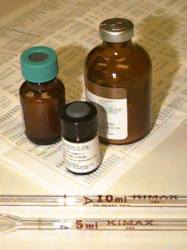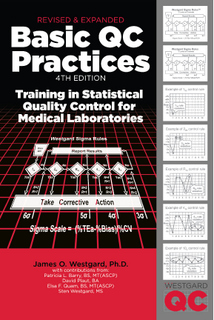Basic QC Practices
QC - The Materials
Elsa F. Quam, BS, MT(ASCP) is one of our most popular guest essayists. Elsa rightly points out that while we concentrate on the statistics of quality control, we can't forget the selection of the control materials. Important attributes such as the stability, vial to vial variability, assayed versus unassayed, appropriate analyte levels, and pretreatment procedures affect the very success of the control procedure.
- Control solutions, control materials
- Matrix effects
- Stability
- Vial to vial variability
- Assayed versus unassayed
- Analyte levels
- Pretreatment steps
- Conclusions
- References
 The purpose of a statistical quality control procedure is to monitor the analytical quality of the measurement during stable operation, detect changes from the stable operation, and eliminate reporting of results with medically important errors [1]. From the technologist’s standpoint, the objectives of the control procedure are simply to "alert me when the method has a problem" and "don't alert me when the method is working okay." These correspond to "true alarm" and "false alarm" situations, which are characteristics of the QC procedure. In short, technologists want to know about real problems, but can't afford to waste time when the method's working okay. Any additional information that can aid in the troubleshooting the method is an "extra bonus."
The purpose of a statistical quality control procedure is to monitor the analytical quality of the measurement during stable operation, detect changes from the stable operation, and eliminate reporting of results with medically important errors [1]. From the technologist’s standpoint, the objectives of the control procedure are simply to "alert me when the method has a problem" and "don't alert me when the method is working okay." These correspond to "true alarm" and "false alarm" situations, which are characteristics of the QC procedure. In short, technologists want to know about real problems, but can't afford to waste time when the method's working okay. Any additional information that can aid in the troubleshooting the method is an "extra bonus."
Much has been written about how to perform the statistical calculations needed for quality control procedures, how to choose control rules, how to apply the rules, how to construct control charts, and how to interpret results from the control procedures, all of which assume we have found appropriate stable control materials. We need to pay careful attention to the selection of the control materials. Important attributes are the stability, vial to vial variability, assayed versus unassayed, appropriate analyte levels, and pretreatment procedures. The very success of the control procedure depends upon these attributes!
Control solutions, control materials
The International Federation of Clinical Chemistry defines a control solution or control material as a "specimen or solution which is analyzed solely for quality control purposes, not for calibration" [2]. We use the term control material or control product to refer to a control solution that is available, usually commercially, in liquid, frozen, or lyophylized form, packaged in small bottles suitable for use on a daily basis. Such control materials are widely available today for most laboratory tests. They can be obtained from manufacturers who specialize in the production of control materials, and also are often provided by the same companies who are selling you the reagents, methods, and instrument systems. It is common today to purchase complete testing packages that include the necessary control materials.
We invite you to read this complete lesson.
To read the entire, updated version of this article, we invite you to purchase the Basic QC Practices manual, Fourth Edition, or join the Basic QC Practices online course.

